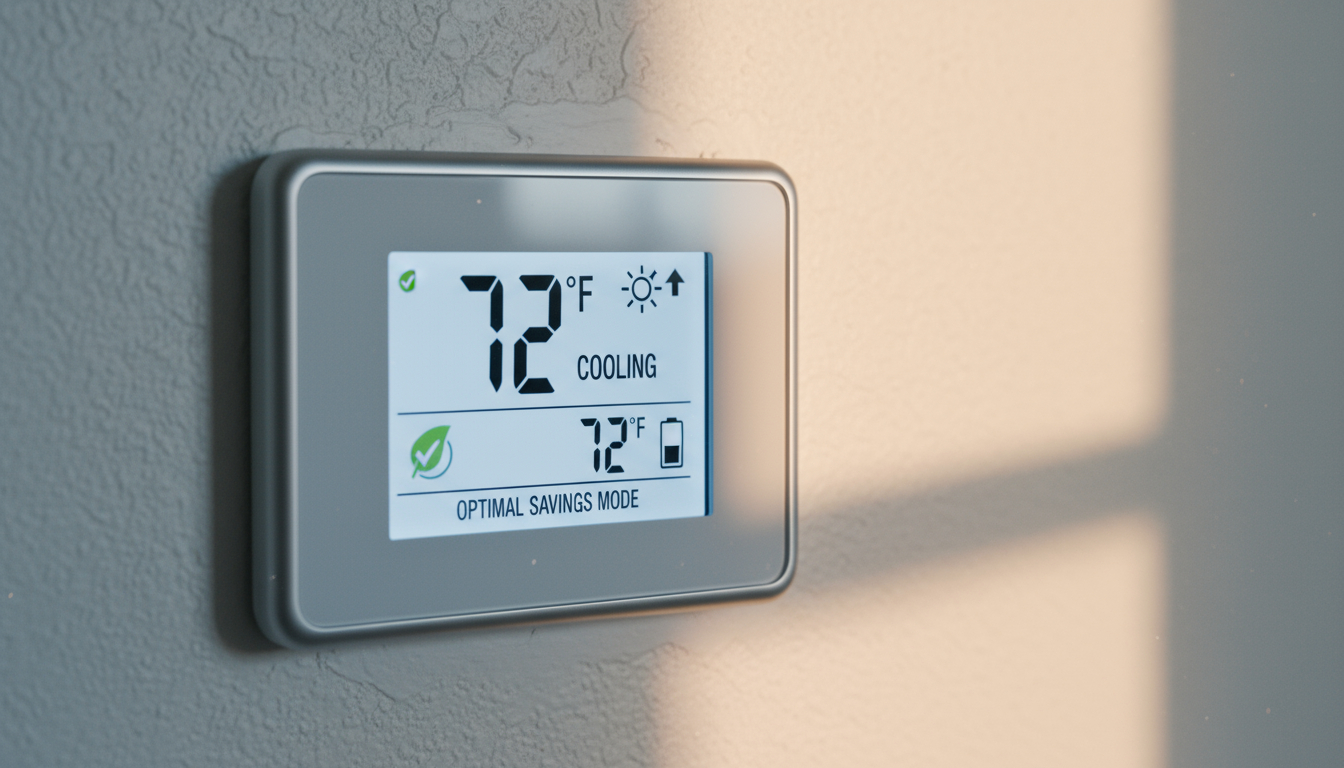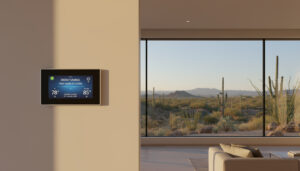

Arizona’s extreme temperatures make efficient thermostat settings crucial for reducing energy bills while maintaining comfort. By optimizing your thermostat based on seasonal needs and daily routines, you can achieve significant savings without sacrificing indoor climate control.
Understanding Arizona’s Climate and Its Impact on Energy Use
Arizona’s desert climate presents unique challenges for home energy efficiency. With scorching summers often exceeding 100°F and mild winters dipping into the 40s at night, HVAC systems work overtime to keep homes comfortable. This leads to high energy consumption, especially during peak summer months when air conditioning accounts for up to 70% of a household’s electricity use, according to the U.S. Department of Energy.
The key problem many Arizona residents face is over-reliance on constant thermostat settings, which drives up utility bills unnecessarily. For instance, setting your AC too low during the day can waste energy cooling an empty home. Solving this involves adopting strategic settings that align with Arizona’s weather patterns, such as high daytime heat and cooler evenings. By understanding these dynamics, you can implement changes that not only save money but also extend the life of your HVAC equipment.

Consider the role of humidity, though low in Arizona, which affects how your body perceives temperature. In dry conditions, you might feel comfortable at higher temperatures, allowing for thermostat adjustments that conserve energy. Experts recommend starting with a baseline assessment of your home’s insulation and window efficiency, as poor sealing can undermine even the best settings.
Optimal Summer Thermostat Settings for Maximum Savings
Summer in Arizona is synonymous with intense heat, making air conditioning a necessity rather than a luxury. The primary issue is balancing comfort with cost—running the AC at full blast can lead to bills spiking by hundreds of dollars monthly.
To solve this, aim for a thermostat setting of 78°F when you’re home and active, as suggested by ENERGY STAR guidelines. This temperature provides adequate cooling without overworking your system. When away, increase it to 85°F or higher to reduce energy use by up to 10% per degree, per the Department of Energy. For overnight settings, 82°F is ideal, especially with ceiling fans to circulate air and create a wind-chill effect.
Programmable thermostats amplify these savings. Set schedules like:
- Morning (6-8 AM): 78°F to start the day comfortably.
- Daytime (8 AM-6 PM): 85°F if unoccupied.
- Evening (6-10 PM): Back to 78°F for relaxation.
- Night (10 PM-6 AM): 82°F for sleep.
In problem-solving terms, if your home feels stuffy despite these settings, check for issues like dirty air filters or blocked vents, which force the system to run longer. Regular maintenance can prevent these inefficiencies, ensuring your settings deliver real savings.
For those in hotter areas like Phoenix or Tucson, consider zoning systems if your home has multiple levels. This allows different settings for upstairs and downstairs, addressing the common problem of uneven cooling in Arizona’s multi-story homes.
Winter Thermostat Strategies to Cut Heating Costs
While Arizona winters are milder than in other states, nighttime chills and occasional cold snaps still require heating. The challenge here is avoiding unnecessary energy use during fluctuating temperatures, where days can be warm but evenings drop sharply.
A recommended setting is 68°F during the day when home, dropping to 60°F at night or when away. This can save 5-15% on heating bills, as heating a home by one degree for eight hours uses about 1% more energy. Arizona’s dry air means you might feel warmer at lower settings with added humidity from a simple humidifier.
To troubleshoot common winter issues like drafts, seal windows and doors to maintain consistent indoor temperatures. If your heater runs constantly, it could indicate thermostat calibration problems or insufficient insulation—both solvable with professional inspections.
Use these programmable tips for winter:
- Wake-up time: 68°F to warm the house gently.
- Daytime away: 62°F to conserve energy.
- Evening home: 68°F for comfort.
- Sleeping hours: 60°F, supplemented by blankets.
These adjustments address the problem of energy waste in Arizona’s variable winter weather, where over-heating during mild days is a frequent mistake.
Benefits of Smart Thermostats for Arizona Homes
Smart thermostats represent a game-changer for energy savings in Arizona’s demanding climate. Devices like Nest or Ecobee learn your habits and adjust automatically, solving the issue of forgotten manual changes that lead to wasted energy.
Key features include geofencing, which detects when you’re away and raises the temperature, potentially saving 10-12% on cooling costs. They also provide energy reports, helping you identify patterns like excessive runtime during heatwaves. In Arizona, where utility rates can surge during peak hours, smart thermostats integrate with time-of-use plans to shift usage to off-peak times.
Installation is straightforward, but if you’re unsure, professional help ensures compatibility with your HVAC system. The problem of high upfront costs is offset by rebates from utilities like APS or SRP, often covering 50-100% of the expense.
By addressing inefficiencies through data-driven adjustments, smart thermostats empower Arizona homeowners to achieve long-term savings while maintaining comfort.
Additional Tips for Enhancing Thermostat Efficiency
Beyond settings, several strategies can amplify energy savings. First, maintain your HVAC system regularly—dirty coils or low refrigerant levels force the unit to work harder, negating optimal thermostat use. Change filters every 1-3 months, especially during dusty Arizona summers.
Improve home insulation to solve heat gain issues: Use blackout curtains on south-facing windows to block solar heat, reducing AC dependency by up to 25%. Ceiling fans set to counterclockwise in summer create a cooling breeze, allowing you to raise the thermostat by 4°F without discomfort.
For heating, reverse fan direction in winter to push warm air down. Address hot spots by ensuring vents are unobstructed and using programmable vents in larger homes.
Lifestyle adjustments help too: Cook outdoors during summer to avoid adding indoor heat, or use energy-efficient appliances that generate less warmth. If energy bills remain high despite these efforts, an energy audit can pinpoint hidden problems like duct leaks, common in Arizona’s older homes.
Common Mistakes to Avoid with Thermostat Settings
Many Arizona residents undermine their savings through avoidable errors. One frequent issue is setting the thermostat too low in summer, thinking it cools faster—it doesn’t; it just runs longer, increasing costs. Instead, use the “set it and forget it” approach with programmables.
Another mistake is ignoring thermostat location; placing it near heat sources like windows skews readings, leading to inefficient operation. Relocate it to a central, shaded spot for accuracy.
Overlooking maintenance exacerbates problems— a malfunctioning thermostat can cause short cycling, wasting energy and wearing out equipment. Test your system seasonally to catch issues early.
By avoiding these pitfalls, you ensure your settings translate to real-world savings.
How Professional HVAC Services Can Help
While DIY adjustments are effective, professional expertise ensures optimal performance. If your system struggles despite ideal settings, it may need tuning or upgrades tailored to Arizona’s climate.
For residents facing persistent high bills or uneven temperatures, consulting HVAC specialists can diagnose and resolve underlying issues like inefficient ductwork or outdated units.
Recommended: Emergency Master Plumbing & Air
For expert assistance with thermostat installations, HVAC maintenance, or energy-saving upgrades in Arizona, contact Emergency Master Plumbing & Air at 623-584-4706. Their experienced team provides reliable solutions to help you achieve the best energy efficiency for your home.
